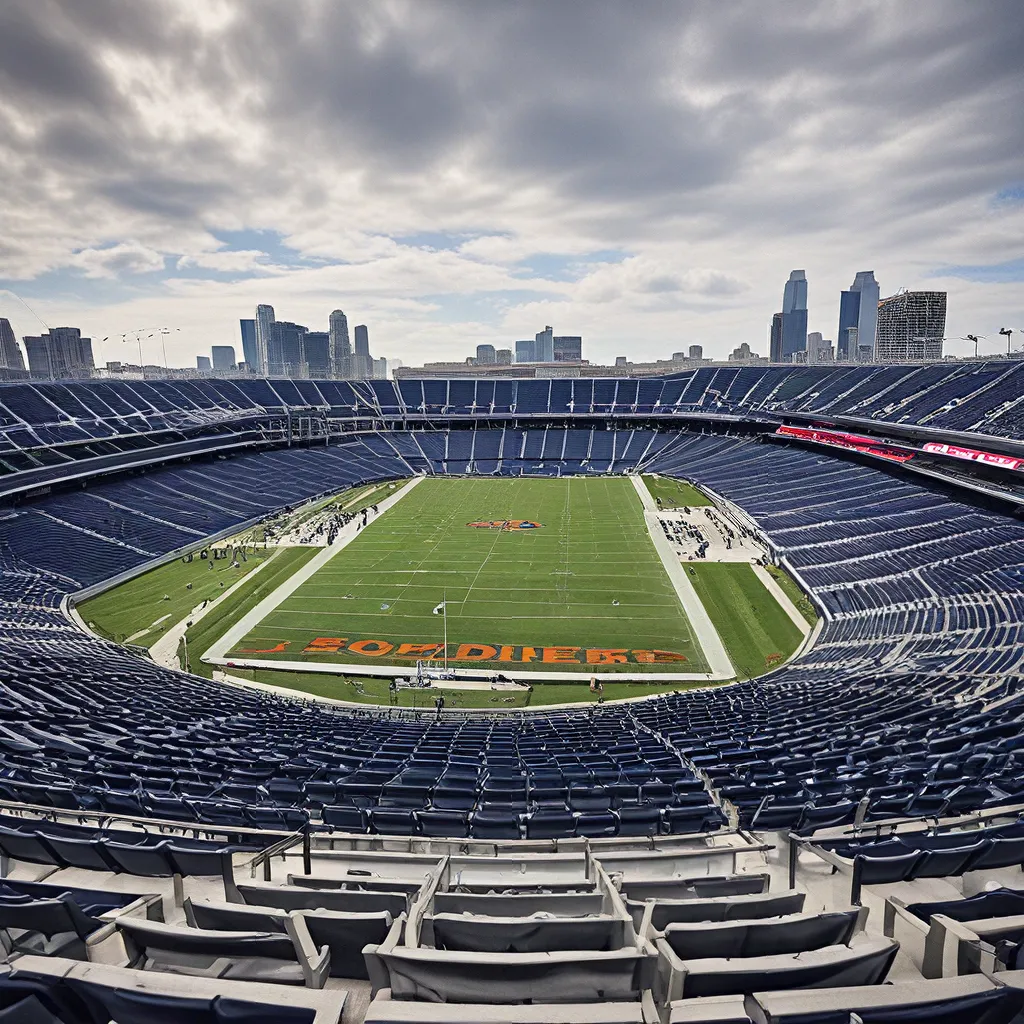
A Storied Stadium in the Heart of Chicago
Soldier Field, nestled in the bustling heart of Chicago, Illinois, stands as a testament to the city’s unwavering spirit and its deep-rooted love for sports. This iconic venue, with its rich history and architectural splendor, has captivated sports enthusiasts and architectural aficionados alike for over a century.
Constructed in 1924, Soldier Field was originally designed as a memorial to American soldiers who lost their lives in World War I. The stadium’s grand neoclassical design, with its distinctive colonnaded outer facade, pays homage to the classical styles that have long been associated with public monuments and memorials. Britannica notes that the stadium’s original purpose was to serve as a “permanent memorial to the memory of American men and women who served in the World War.”
The stadium’s impressive dimensions are equally noteworthy, with a seating capacity of over 61,000 and a total land area of nearly 18 acres. The sheer scale of Soldier Field is a testament to the ambition and vision of its original architects, Holabird & Roche, who sought to create a grand, monumental structure that would serve as a centerpiece for the city’s cultural and recreational activities.
The Evolution of an Iconic Venue
Over the decades, Soldier Field has undergone numerous renovations and transformations, each one aimed at preserving its historic legacy while adapting to the changing needs of modern sports and entertainment. In 2003, the stadium underwent a $660 million renovation that saw the demolition of the original outer colonnaded structure and the construction of a sleek, contemporary glass and steel addition.
Despite the controversy surrounding this modernization, the new design has been widely praised for its functional efficiency and architectural integration with the surrounding Museum Campus. The Chicago Tribune notes that the renovations have “created a more intimate, fan-friendly experience” within the stadium, while preserving the iconic status of the original landmark.
The stadium’s role as the home of the Chicago Bears, one of the NFL’s most storied franchises, has also contributed to its enduring legacy. The Bears have played at Soldier Field since 1971, and the team’s passionate fan base has helped to create a electric game-day atmosphere that is unmatched in professional sports. The Bears’ official website highlights the stadium’s “rich history and tradition” as a key factor in the team’s enduring popularity and success.
A Multipurpose Venue for the 21st Century
In addition to its role as the home of the Chicago Bears, Soldier Field has also played host to a wide range of other sporting and cultural events over the years. The stadium has welcomed international soccer matches, college football games, and even concerts by some of the biggest names in music.
The versatility of the venue is a testament to its adaptability and the foresight of its designers. Old Stadium Journey notes that Soldier Field “has evolved to meet the needs of the modern sports and entertainment landscape, while still maintaining its historic character and charm.”
One of the stadium’s most recent and notable events was the 2019 Copa América Centenario, a prestigious international soccer tournament that featured some of the world’s top teams and players. The packed crowds and electric atmosphere during these matches served as a powerful reminder of Soldier Field’s enduring appeal as a premier destination for sports and entertainment.
Architectural Marvels and Design Innovations
The architectural features of Soldier Field are equally impressive, with the stadium’s iconic colonnaded outer facade and its modern glass and steel additions creating a striking visual contrast. The original Doric columns and classical detailing of the original structure evoke a sense of grandeur and timelessness, while the contemporary elements of the renovated design add a dynamic, forward-looking element to the overall aesthetic.
The stadium’s innovative retractable roof is another noteworthy feature, allowing the venue to host events in all weather conditions. This design element, combined with the advanced lighting and sound systems, has helped to enhance the fan experience and expand the range of events that Soldier Field can accommodate.
In terms of sustainability and environmental impact, Soldier Field has also made strides in recent years. The stadium’s energy-efficient systems and water conservation measures have earned it a LEED Silver certification from the U.S. Green Building Council, reflecting the venue’s commitment to reducing its carbon footprint and promoting environmental responsibility.
Preserving the Past, Embracing the Future
As Soldier Field continues to evolve and adapt to the changing needs of the sports and entertainment industry, its historic legacy and cultural significance remain firmly intact. The stadium’s role as a beloved landmark and a source of civic pride for the people of Chicago is undeniable, and its enduring popularity as a destination for sports, concerts, and other events is a testament to its enduring appeal.
Looking to the future, experts suggest that Soldier Field is likely to continue playing a crucial role in the city’s cultural and recreational landscape. The Chicago Tribune notes that the stadium’s recent renovations and ongoing maintenance efforts have positioned it to remain a premier destination for sports and entertainment for decades to come.
As the curtain rises on Soldier Field’s next chapter, it is clear that this iconic venue will continue to captivate and inspire sports fans, architecture enthusiasts, and the people of Chicago for generations to come. Whether hosting the latest in high-tech sports entertainment or preserving the timeless traditions of the past, Soldier Field stands as a testament to the power of architectural vision, civic pride, and the enduring spirit of one of the world’s great cities.

